

Classic Buses Profiles
W. Alexander and Sons - 1950s Single Deckers (by Dick Gilbert)
Last updated 19 October 2019

SOME LINKS WITHIN THIS WEBSITE: Home Email Links THE COMPLETE WEBSITE MENU Events Diary Halfcab list Small-Ads Classic Irish Buses Classic Manx Buses
On this page we celebrate the huge fleet of 1950s front-engined single deck buses and coaches operated by W. Alexander and Sons throughout Scotland. This is not intended as a comprehensive fleet list, but came about as a result of the many fine pictures sent to me by George Bett, who was photographing buses in Scotland from the 1950s onwards, and has kindly made his collection available to me for display on the website. So this is really a photo scrapbook with expanded captions.
Acknowledgements: All photos on this page are by George Bett unless otherwise credited, and I am most grateful to him (and others) for allowing me to use them. Information has been gleaned from many sources, but special mention must be made of Allan T. Condie, whose thorough (and beautifully illustrated) book The Bluebird Era has been an invaluable reference. To obtain a copy of this, or his other works on Alexander double deckers and underfloor-engined single deckers, contact Allan T. Condie Publications, 6 St. Mary's Drive, Kinnoull, Perth PH2 7BY. Tel: 01738-446200. I recommend it.

It's the end of the road for these withdrawn 1950s Alexander (Northern) Leylands at Arbroath on 27 June 1971. Photo: George Bett.
Alexander's Motor Services of Kilsyth started operating in 1923, and W. Alexander and Sons Ltd. was formed in 1924. In 1929 the company joined the SMT group of companies, but retained its independence and, by this time, was operating throughout much of Scotland.
Simultaneously with this expansion, Alexanders had been building bus and coach bodies for their own use since their earliest operating days. From 1930 onwards this aspect of the business also expanded, and they began to produce bodywork for other members of the SMT group, and later for other companies as well. This enterprise was to become Walter Alexander and Co. (Coachbuilders) Ltd. in 1947, and is still active today.
The company's acquisition and expansion programme took a different turn in 1952, when all operations in the Inverness area were transferred to Highland Omnibuses. In 1961 the company, and its fleet of 2000 vehicles, was reorganised into three areas, Fife (based on Kirkcaldy), Northern (based at Aberdeen), and Midland (based at Falkirk). Each subsequently acquired its own livery, with Fife being red and cream, Northern yellow and cream, and Midland blue and cream.
Coaches from 1934 onwards were cream (or off-white) with variations of blue roofs and lining, and were given a Bluebird emblem, which became synonymous with Alexander's coaching activities, even after the adoption of the new regional liveries in 1961.
Vehicles were identified by a fleet number and a type prefix. The system varied over the years, but for the sake of the pictures shown here, A = Albion (pre war) and AEC Regal (post-war), BA = Albion (post-war), C = Commer, D = Daimler, F = Foden, G = Guy, K = Leyland Cheetahs, N and P = Leyland Lions and Tigers (becoming PA post-war), and W = Bedford.
Subsequent to the 1961 division into three areas, a further prefix was added to denote the district so, for example, PA100 would become NPA100, denoting a post war Leyland Tiger, fleet number 100, operating for the Northern division.
I hope you will enjoy this collection of pictures and, if you spot any mistakes, please let me know and I'll try and put them right.
1950 - LEYLAND TIGER PS1
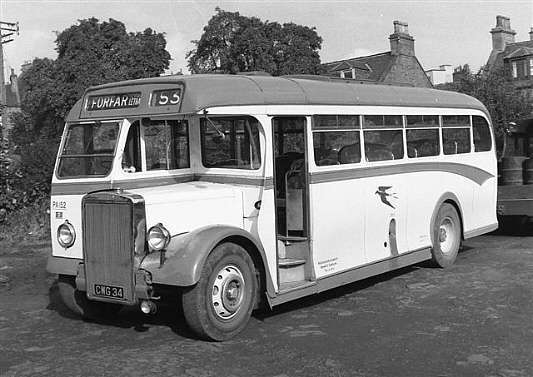
Alexander-bodied Leyland Tiger PS1 PA152 (CWG 34) at Westfield Depot, Dundee in 1957. Photo: George Bett.
By far the majority of the Alexander Tiger PS1 fleet was bodied by Alexander themselves. Among these were a batch of fifteen delivered in March/April 1950, PA146-60 (CWG 28-42). Like all the others, they were 35-seaters, and all lasted around 20 years in service. PA152 was withdrawn in 1971. None of them survive today.
1950 - LEYLAND TIGER PS1
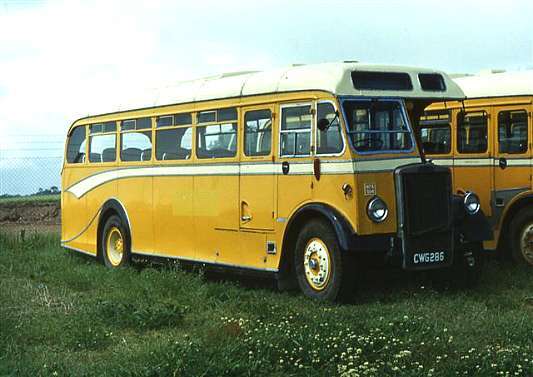
Alexander (Northern) Tiger NPA184 (CWG 286) stored at Arbroath 27 June 1971, after withdrawal. Photo: George Bett.
The torrent of new Leyland Tiger deliveries began to wind down during the summer of 1950, and PA167- PA193 (CWG 269-295) were the last major batch of PS1 halfcabs to be acquired. All had Alexander C35F metal-framed bodies with bus seats, so they were essentially dual-purpose, and all were originally in Bluebird livery. The first were taken out of service in the summer of 1968, and the last to be withdrawn was this one, PA184, which had become NPA184 and been repainted yellow when it was allocated to Alexander (Northern) after 1961. This vehicle survives, with Cumbria Classic Coaches.
1950 - LEYLAND TIGER PS1
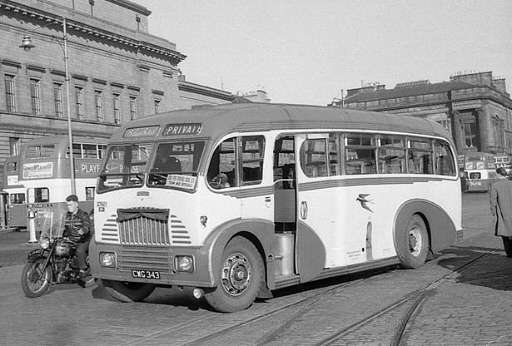
Leyland Tiger PS1 with Burlingham full-front body, of Aberhill (Leven) Depot, Dock Street, Dundee in the mid 1950s. Photo: George Bett.
This is numerically the very last Leyland Tiger PS1 to enter service with Alexanders. PA216 (CWG 343) was the last of fourteen delivered in July 1950, numbered PA203-PA216 (CWG 330-343) with full-fronted FC33F bodies built by Burlingham and known as sun saloons. Halfcabs were starting to look a bit old-fashioned by 1950, and a variety of solutions was being offered by the various bodywork manufacturers. This option was perhaps not the most attractive. PA216 was one of the first to be withdrawn, in 1965.
1950 - LEYLAND TIGER PS1
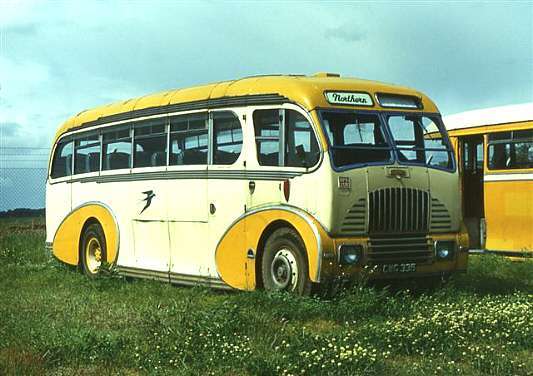
Put out to grass. Withdrawn Tiger PS1 / Burlingham NPA208 (CWG 335) at Arbroath Depot, 29 June 1971. Photo: George Bett.
Another of the fourteen Burlingham sun saloon coaches, after withdrawal from service. Despite being heavy, and not likely to win a beauty contest, most of the fleet lasted until 1971. Here we see the end of the line for PA208, which had gained a yellow livery and become NPA208 in 1961 with the split of Alexander's network into regional divisions. None of these vehicles has survived.
1951 - DAIMLER CVD6
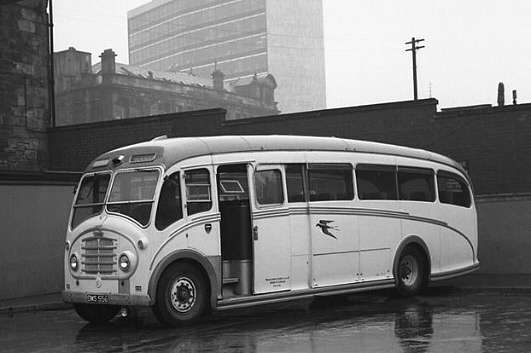
Alexander Daimler CVD6 coach D43 (DMS 556) at Glasgow in the late 1950s. Photo: George Bett.
And here is ECW's design for replacing the halfcab. Known as the Queen Mary, this style appeared with many fleets across the country (although seldom on a Daimler chassis), and became very familiar to patrons of Eastern/Western/ Southern National in England. D43 was part of a delivery of thirteen 8ft wide Daimlers of this type, delivered in the summer of 1951 as D36-D48 (DMS 549-561). They were heavy and unpopular, so the entire batch was sold in 1965.
1951 - AEC REGAL III
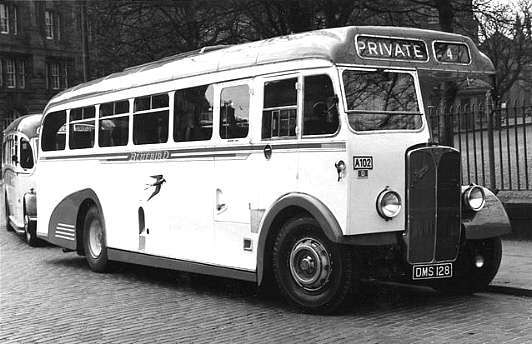
Alexander AEC Regal A102 (DMS 128) of Dundee depot, at Albert Square, Dundee 13 April 1958. Photo: George Bett.
The last six AEC Regals to be acquired by Alexander, A99-A104 (DMS 125-130) were the only ones of the 682 variety. Whereas the Regal III 962 had many new features, including a 9.6 litre engine, the 682 was still essentially a Regal I, with the smaller 7.7 litre engine and little in the way of improvements. But this suited some customers, and the chassis limitation of 7ft 6ins wide and 27ft 6ins long was anyway governed by regulations in force at the time. However in 1950 the size restrictions were increased, so advantage could be taken of the increased capacity of larger vehicles. During the transitional phase curious hybrids appeared, and here we see A102 (delivered in May 1951) with an Alexander 8ft wide body on a 7ft 6ins wide chassis (notice the overhang under the wheelarches). These coaches lasted 20 years in service, and one example (A104) survives today.
1952 - LEYLAND TIGER OPS2
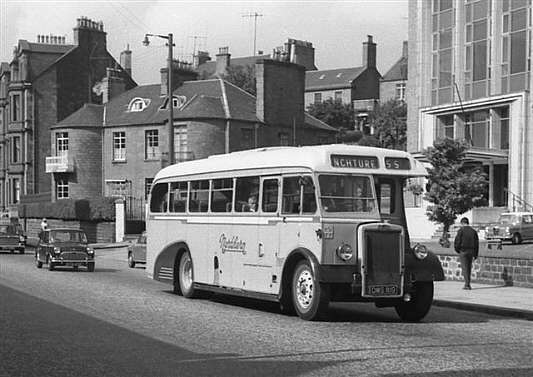
Alexander (Northern) Leyland Tiger OPS2 NPB6 (DMS 819) in Perth Road, Dundee in the early 1960s. Photo: George Bett.
Twenty OPS2 Tigers were built for New Zealand in 1948, but the order was then changed to the OPS3 model. The twenty chassis were then acquired by Alexander but remained in store until 1952. The OPS2 model (export or overseas PS2) had the 9.8 litre O.600 engine, offered 7ft 6ins or 8 feet wide options, and were designed for 27ft 6ins bodies. These examples were OPS2/1 versions (intended for 7ft 6ins wide buses) but, like the AEC Regals shown above, were eventually given 8ft wide Alexander C35F coach bodies (and again the overhang is visible in the photo), slightly extended in length to 28ft 5ins.
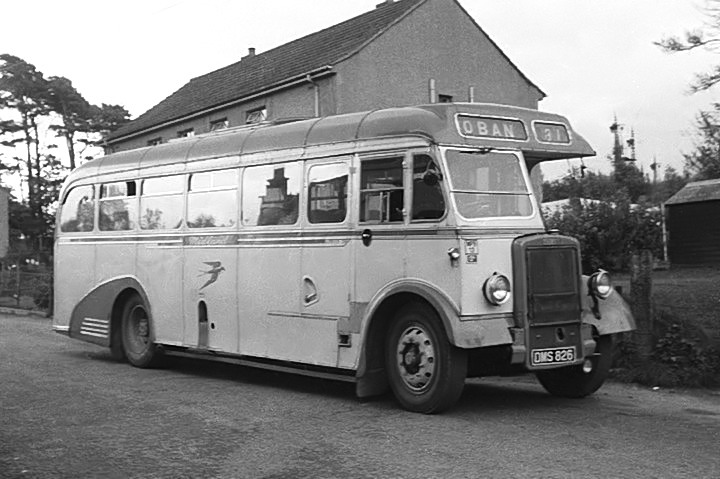
From the same batch this is Alexander (Midland) MPB13 (DMS 826) seen on 31 Aug 1963 at Connel Ferry on a service to Oban. Photo by kind permission of Peter Bagshawe.
Joining the fleet in January 1952 as PB1-PB20 (DMS 814-833), six went into the coaching fleet of David Lawson. Most of the OPS2s served for around 20 years, with PB6 shown here (later NPB6 in Northern service) lasting until 1971.
1952 - LEYLAND TIGER OPS2
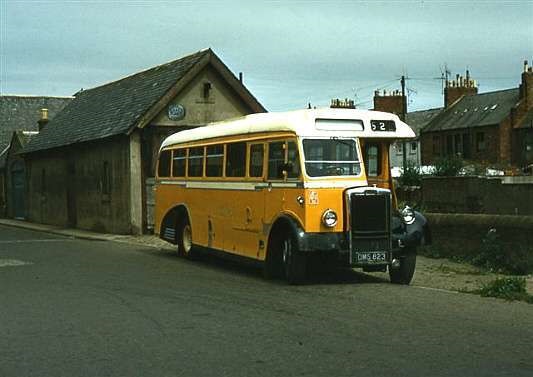
Leyland OPS2 Tiger NPB10 (DMS 823) at Arbroath, 21 July 1970. Photo: George Bett.
Here is another of the twenty OPS2 Tigers. By the time this picture was taken, more than half of the batch had been withdrawn, and PB10 (later NPB10) shown here was destined to be the last of them all to go (February 1972). In fact, of all the many hundreds of Leyland single-deck halfcabs Alexander had acquired since the 1920s, I believe only PA123 (BWG 528) lasted longer - by one year. NPB10 shown here, and also PB7, have been preserved and are currently awaiting restoration by their respective owners at the Scottish vintage bus museum.
For more Alexander buses see 1930s single deckers and 1940s Single Deckers.
For many other buses, have a look at all the other profiles on the Classic
Buses menu page.
SOME LINKS WITHIN THIS WEBSITE: Home Email Links THE COMPLETE WEBSITE MENU Events Diary Halfcab list Small-Ads Classic Irish Buses Classic Manx Buses